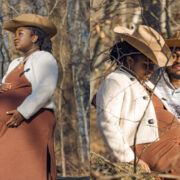8 Things You Probably Didn’t Know Your Baby Is Doing In Your Womb?

Right from your womb, your baby is already living it up. They’ve got buffets, parties and reading clubs going on in there. We did a little bit of intelligence gathering of what goes on under cover of mama’s fleshy belly hump. Let’s fill you in on the scoop.
1.Taking in the Sights
By 18 weeks, your baby can detect changes in how light or dark their environment is. In a bright room, they can see dark shapes or men as moving shadows. The eyelids however remain closed until about 7 months when the retina would have reached its final development stage. Close to their delivery, they will be able to blink and can even cry. At this stage, if you point a powerful torchlight towards your belly, you may just feel the baby move trying to turn away from the light the way you would if the light is pointed in your face.
2. They Can Hear You
Who said babies can’t appreciate good music? Studies show that as early as 6 to 10 weeks, the inner middle and outer ears have already taken shape and are developing. Give a few weeks more and your baby would have already started to hear your voice, your heart beating, it’s different rhythms and even your blood flowing merrily through your veins.
You can now start to read and sing to your baby. According to www.bellybelly.com, they may not make sense of the words but they can hear and appreciate the rhythm of your spoken words and songs. You have to be careful too because loud, raucous noise can harm your unborn child’s fragile auditory organ. If only your womb had factory fitted ear plugs, eh?
3. Taste Buds
Oh you should know that your baby is chowing down on any and everything you (mom) eat. According to Amy Fleming on www.guardian.com, the 15 week old foetus can recognise sweet/sugary flavours and prefer this to other tastes. They do this by drinking more amniotic fluid when it’s sweet than when it’s salty or bitter.
4. Fragrances & Aromas
As we mentioned earlier, her sense of smell is one of the senses she uses to recognise different food flavours. But she’s not just recognising them, she’s also memorising them. Countless studies have been used to show how a mother’s diet while she’s pregnant determines the child’s food taste and preferences. These studies also show that the amniotic fluid also captures the mother’s peculiar “smell”. According to www.parents.com, studies showed that one day old babies preferred lactating pads won by their mothers to those of other lactating moms.
5. Developing a Habit
Researchers show that babies really start living their lives from the womb. Technology in a four dimensional image has been able to show that babies start developing habits like thumb sucking before they are born. Other studies have also shown how a particular set of twins, while in the womb, would play with each other by rubbing their cheeks together with the membrane in between them. After being born, the twins got a lot of giggles by standing on either side of a curtain and touch each other’s face. Some habits are really formed in the womb.
6. Show Emotions
Babies are being prepared for life in open air but the “factory” is in liquid, amniotic fluid. Nevertheless, babies start to learn how to breathe by drawing in the amniotic fluid through their lungs, in and out. They get oxygen through the almighty umbilical. While they are very sensitive to mom’s emotions, they express theirs by crying and smiling. How or why they would sneeze is a puzzle to me but yes, unborn babies do sneeze. They have also been spotted to yawn…like it’s really boring in there.
7. They Like To Move It, Move It.
But it’s not boring down there. Not with all that movement that make expecting mothers call out to whoever is around to “come see, come see. She’s moving!!”. Observant mothers and professional doctors have explained that most of this movement is done just after the mom has eaten. Perhaps it’s the excitement and energy from a spicy and nutritious meal that causes it but the little ones kick and wiggle and even give mom the thumbs up. It must be the good food.
Other things may make the baby move though. Like we just mentioned, they’re sensitive to mom’s emotions. If mom is agitated, they may feel and express it by wiggling. They may also move when startled by bright lights or strange and loud sounds.
8. Sleep Sleep Sleep
We can see that it’s never a dull moment in there. Even though, according to experts, by 32 weeks, the unborn baby would sleep 90 to 95% of the time and closer to when they are born they sleep just a little bit less. These sleeping hours are divided into deep sleep and Rapid Eye Movement sleep.
Now you see why I say they’re living the life in mama’s belly? It’s really wonderful to know that all this is going on inside another human being.



Noted. Thanks for sharing.
thnx mim